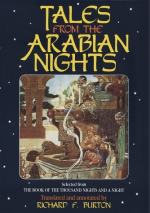P. 84, note 4.—Although it has nothing to do with the present story, yet I may point out the great importance of the bridle in all the folk-tales which deal with the transformation of human beings into domestic animals. It is clearly implied (though not actually expressed) in the story of Julnar the Sea Born (No. 153) that the power of Abdallah and Badr Basim over Queen Lab, while she bore the form of a mule, depended entirely on their keeping possession of the bridle (cf. Nights, vol. vii., p. 304, and note). There are many stories of magicians who transform themselves into horses, &c., for their friends to sell; but the bridle must on no account be given with the horse. Should this be neglected (purposely or otherwise) the magician is unable to reassume his human form at will. Cf. also Spitta-Bey’s story No. 1 (infra).
The Tale of the Warlock
and the Young Cook of Baghdad
(Pp.
95-112).
This story appears in Chavis and Cazotte’s version, and in the various translations made from the French, in a very highly elaborated form, under the title of “The Adventures of Simoustapha, and the Princess Ilsetilsone.” The Caliph and his Wazir are identified with Harun Al-Rashid and Ja’afar, but they suffer no transformations at the hands of the Magician after whose death Prince Simoustapha is protected by Setelpedour Ginatille, whose name is interpreted as meaning the Star of the Seven Seas, though the first name appears rather to be a corruption of Sitt El Bubur. She is the queen of Ginnistan, and the daughter of Kokopilesobe (Satan), whose contests with Mahomet and Michael (the former of whom continues the conflict by “becoming man”) are described on the approved Miltonic lines. Her chief councillors are Bahlisboull (Beelzebub) and Asmonchar (Asmodeus), but ultimately she falls in love with Simoustapha, and adjures her sovereignty, after which he carries her off, and marries her, upon which the mother of Ilsetilsone, “the sensible Zobeide, formed now a much truer and more favourable judgment of her daughter’s happiness, since she had shared the heart of Simoustapha with Setelpedour, and at last agreed that the union of one man with two women might be productive of great happiness to all the three, provided that one of the wives happened to be a fairy.” (Weber, ii. p. 50.) A most encouraging sentiment for would-be polygamists, truly, especially in Europe, where fairies appear to fly before the advance of civilisation as surely as the wild beasts of the forest!
P. 99.—These apparitions resemble those which usually precede the visions which appear in the well-known pool of ink. But the sweeper is not mentioned in the present story, nor do I remember reading of his appearing in cases of crystal seeing, though Dante Gabriel Rossetti introduces him into his fine poem, “Rose Mary,” as preparing the way for the visions seen in the beryl:
“’I
see a man with a besom grey
That
sweeps the flying dust away.’
’Ay,
that comes first in the mystic sphere;
But
now that the way is swept and clear
Heed
well what next you look on there.’”




